NVIDIA’s GeForce GTX 590: Duking It Out For The Single Card King
by Ryan Smith on March 24, 2011 9:00 AM ESTCrysis: Warhead
Kicking things off as always is Crysis: Warhead, still one of the toughest games in our benchmark suite. Even three years since the release of the original Crysis, “but can it run Crysis?” is still an important question, and for three years the answer was “no.” Dual-GPU halo cards can now play it at Enthusiast settings at high resolutions, but for everything else max settings are still beyond the grasp of a single card.
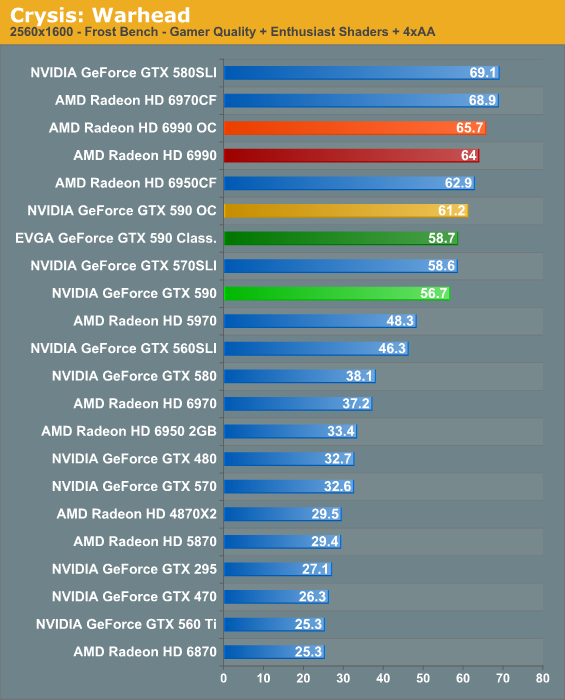
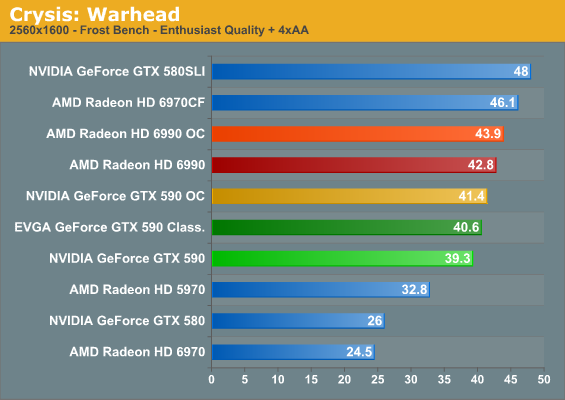
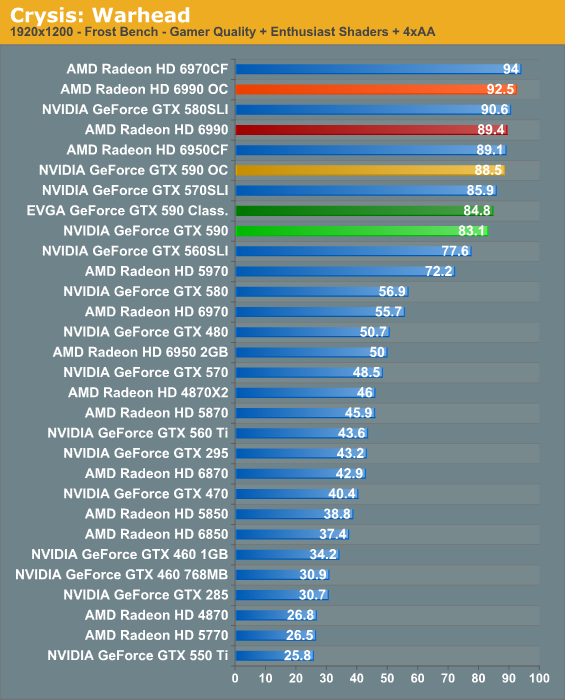
Crysis is often a bellwether for overall performance; if that’s the case here, then NVIDIA and the GTX 590 is not off to a good start at the all-important resolution of 2560x1600.
AMD gets some really good CrossFire scaling under Crysis, and as a result the 6990 has no problem taking the lead here. At a roughly 10% disadvantage it won’t make or break the game for NVIDIA, but given the similar prices they don’t want to lose too many games.
Meanwhile amongst NVIDIA’s own stable of cards, the stock GTX 590 ends up slightly underperforming the GTX 570 SLI. As we discussed in our look at theoretical numbers, the GTX 590’s advantage/disadvantage depends on what the game in question taxes the most. Crysis is normally shader and memory bandwidth heavy, which is why the GTX 590 never falls too far behind with its memory bandwidth advantage. EVGA’s mild overclock is enough to close the gap however, delivering identical performance. A further overclock can improve performance some more, but surprisingly not by all that much.
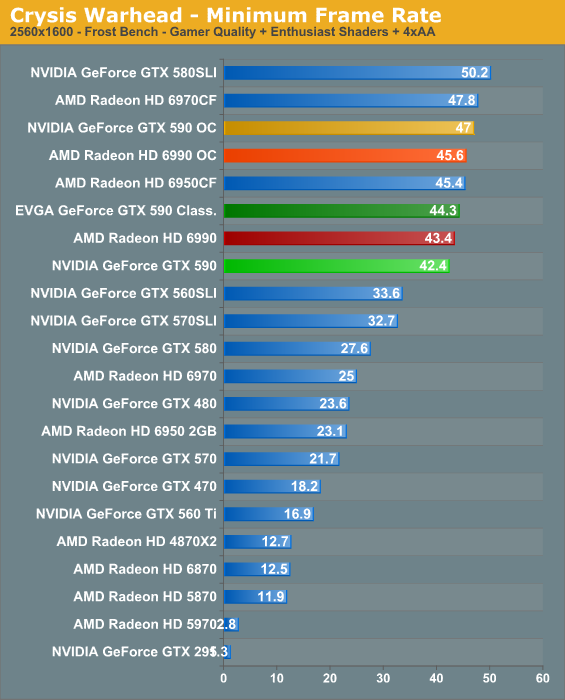

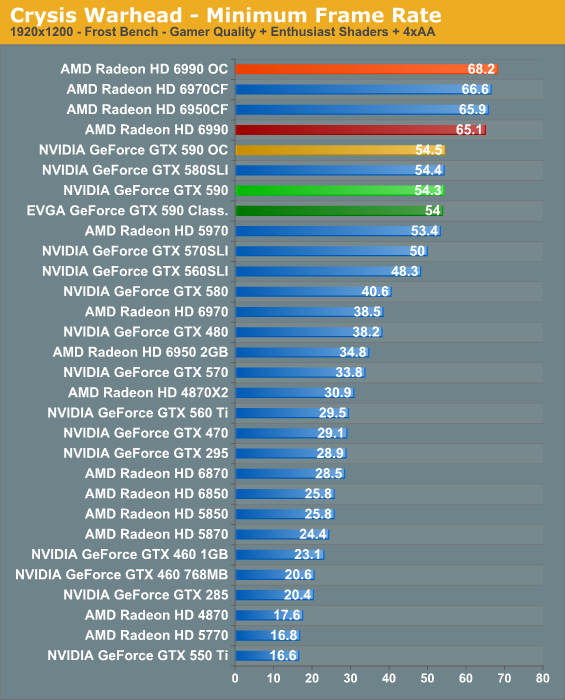
The minimum framerate ends up looking better for NVIDIA. The GTX 590 is still behind the 6990, but now it’s only by about 5%, while the EVGA GTX 590 squeezes past by all of .1 frame per second.










123 Comments
View All Comments
Abot13 - Saturday, March 26, 2011 - link
Well there is advertising and advertising. Asking multiple monitor manufacturers to supply sets of screens in order to test them for multi monitor setups, where the best sets will be used for a longer test period to see how they keep up over time, doesnt interfere with your journalistic integrity, bit for the manufacturers the cost can be written of as PR/advertising costs.in the end your readers will get the information they want, your integrety will be intact and we also will find out what the best monitors are for multi monitor setups.
Shouldnt be that hard now should it?
PrinceGaz - Friday, March 25, 2011 - link
Once you are dealing with framerates above about 80fps at the highest resolutions and quality settings, multi-monitor is one option, or it is time to start cranking up the anti-aliasing as the results are otherwise irrelevant.With one card doing 100fps and another managing 140fps in a game, the best card for that game is the one which is cheapest even if only slightly, unless you can do something to bring the framerates down in a useful way, and higher AA than 4x is the way to go.
Ryan Smith - Friday, March 25, 2011 - link
As a general principle I agree, however 8x AA really doesn't do anything for IQ. I'd rather turn on SSAA/TrAA/MLAA, however AMD and NVIDIA do not have a common AA mode beyond DX9 SSAA. So for DX10/11 titles, MSAA is still the lowest common denominator.DarknRahl - Thursday, March 24, 2011 - link
I agree. Anandtech always seems to have a nvidia bias to their video card reviews.It sticks in the craw as I dig all their other reviews for other products but video card wise I go elsewhere.
B3an - Thursday, March 24, 2011 - link
No they dont. It just that for some reason AMD attracts more morons that like to moan about these non-existent things. And i own AMD cards before you say anything else stupid.softdrinkviking - Sunday, March 27, 2011 - link
100% agree. i own an AMD card too, and i felt like anandtech was extremely positive about the 5800 series when i bought that card.it also looks like they are leaning towards the 6990 vs the 590 in this very article. to paraphrase... the 6990 is going to be better for current new games and future games, but the 590 seems to do a bit better with older titles and new games played at lower resolutions.
i don't understand how anyone could think that makes them nvidia biased. it boggles the mind.
compvter - Thursday, March 24, 2011 - link
Finnish site called muropaketti did some 3x display tests with these new cardshttp://plaza.fi/muropaketti/artikkelit/naytonohjai...
and for your question i would like to answer with other question: Why buy faster cpu if you won't need faster at the moment? Granted there is no limitations like dx compatability, but still you can use your gfx card quite a while. Im still using 3870x2 card (3 years), mainly because there are so few dx11 games.
VoraciousGorak - Thursday, March 24, 2011 - link
For the "hype" they were throwing out with that video preview, I thought they were going to pull a fast one and launch a GeForce 6-series. But a teaser video for a super-enthusiast GPU using existing tech that'll be so rare I'll probably never physically look at one in my lifetime?Color me disappointed.
fausto412 - Thursday, March 24, 2011 - link
yeah.those 700 dollar cards are only to be bought by a rich few.
Improve the $400 price range...that's as high as i'll go these days.
Red Storm - Thursday, March 24, 2011 - link
... are you guys not testing these cards at multi-monitor resolutions? You said yourself in the review that these are marketed towards the high end. Well, the high end isn't just 30" monitors. Multi monitors boast a higher resolution and I think it's important to know how well these dual GPU monsters perform at the level they are marketed towards.